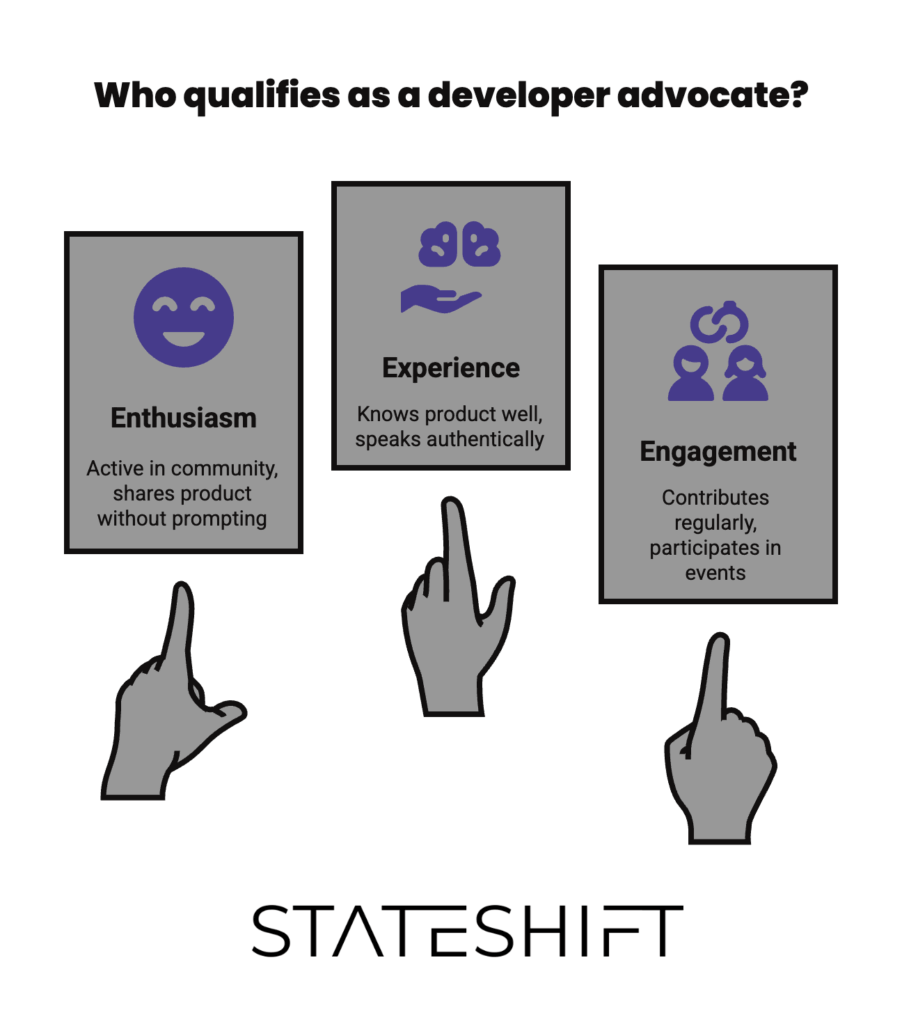Three developers in your Discord keep showing up. They answer questions, share what they are building, and seem genuinely excited about your product.
You want more of them. Not just active users, but real developer advocates who share, teach, and amplify what you are building.
So the question becomes: How do you turn developers into brand advocates in a way that lasts?
Most teams get stuck here. They know developer advocacy matters. Companies such as Stripe and Twilio built large developer movements through structured advocate programs.
But translating “we need advocates” into clear rituals, rewards, and support systems is where good intentions often meet messy reality.
Through our work at Stateshift, helping technology companies build developer ecosystems, we have seen this gap many times. Passionate developers appear, but without structure or guidance, that energy fades instead of multiplying.
Why Developer Advocacy Programs Fail
Most developer advocacy programs fail for predictable reasons. Teams often launch without clear qualification criteria, ask for advocacy without defining what it means, and provide little support for the work they are requesting.
The gap between “developers who like us” and “developers who amplify us” is where structure matters most. Without it, even your most passionate users drift away or burn out.
Successful companies approach this differently.
- Stripe treats developer advocacy as both an internal and external practice. Their advocates help developers master payments while representing the developer’s perspective inside Stripe. Thousands of independent advocates talk about Stripe because the company supports their efforts with useful materials and community systems.
- Twilio launched the Champions Program in 2018 to recognize community members who are both technical experts and teachers. These advocates gain early product access, invitations to exclusive events, and public recognition.
Both companies built repeatable systems, not enthusiasm campaigns.
The Four-Stage Developer Advocacy Framework
This framework originates from Stateshift’s work with developer-focused companies across dev tools, open source, and SaaS. It provides a systematic way to identify advocates, define their work, support their efforts, and maintain long-term momentum.
Stage 1: Qualification — The Three E’s of Developer Advocacy
Start by defining who qualifies as an advocate using the Three E’s: Enthusiasm, Experience, and Engagement.
- Enthusiasm: These developers are already active. They answer questions, share builds, and talk about your product without being asked.
- Experience: They know your product well enough to speak about it authentically.
- Engagement: They have the time and willingness to contribute regularly, whether that means writing tutorials, joining community calls, or presenting at events.
Make each criterion binary, not subjective. Ask questions such as “Has at least one year of product experience?” or “Can commit two hours per week?”
Programs that start with clear qualification criteria avoid the common trap of recruiting enthusiastic people who lack time or experience. Advocacy requires all three E’s working together.

Stage 2: Rituals and Rewards — Building Advocacy Habit
Once advocates are qualified, define the specific rituals that keep them engaged.
Examples include:
- Speaking at conferences or webinars
- Creating technical content such as blog posts or demos
- Running local meetups
- Participating in online community discussions
Start with one or two rituals and write down what success looks like. If the focus is content, clarify the expected formats, cadence, and review process.
Rewards fall into two categories:
- Intrinsic rewards include recognition and visibility. Publicly celebrate advocates, feature them in releases or newsletters, and highlight their work in presentations. Recognition builds professional credibility and pride.
- Extrinsic rewards are tangible. This includes swag, travel stipends, or small payments for major contributions. Match the reward to the effort. A helpful forum answer might earn a quick thank-you, while a conference talk that drives adoption deserves formal recognition and a meaningful gift.
The best advocacy systems balance both forms of reward so participation stays motivating over time.
Stage 3: Support Systems — Reducing Friction for Advocates
The programs that succeed are the ones that remove friction before it starts.
If advocates are writing or speaking, equip them properly. Provide:
- Writing guidelines and review support
- Access to brand assets and images
- Example slide decks and talk templates
- A clear publishing or event process
When Stateshift helps companies launch or rebuild advocacy programs, this support layer often determines success.
One client created detailed playbooks for running meetups, including registration templates and troubleshooting guides. Their advocates quickly moved from struggling to running events confidently.
Support systems turn goodwill into confidence, and confidence into consistent advocacy.
Stage 4: Operating Model — Keeping Developer Advocacy Sustainable
Once the structure is in place, build rhythm into it.
- Regular commitment means defining minimum participation levels, such as one talk per quarter or two content pieces per month. The numbers matter less than the clarity.
- Regular communication means creating spaces where advocates share progress and ideas. A private chat, Slack group, or quarterly call can keep everyone connected.
Peer learning is one of the fastest ways to improve advocacy. When advocates see what works for others, they try it. When they share challenges, they get feedback quickly. This communication loop also helps you identify what support to add next.
Putting the Framework Into Practice
Developer advocacy begins with the energy you already have. The framework gives that energy direction and sustainability.
- Define your Three E’s. Write down what Enthusiasm, Experience, and Engagement mean for your product.
- Identify five to ten qualified developers. Choose people who already participate.
- Select one ritual to start with. Build on what they are already doing rather than creating new work.
- Create simple support materials. Templates, review guides, and basic communication channels go a long way.
- Set a steady rhythm. Keep communication regular so everyone stays aligned and encouraged.
You do not need to create excitement from nothing. You only need to structure what already exists.
This approach has worked across developer ecosystems of all sizes.
One client used the framework to channel organic community energy into a structured writing program. Within three months, ten advocates had published 24 technical articles that drove measurable adoption.
Another client focused on conference advocacy. By using structured speaker guides and templates, their advocates started landing talks at major developer events.
A third example comes from one of our previous clients, The Cloud Native Computing Foundation (CNCF). During one of our Stateshift Live Expert Sessions, Katie Greenly shared how CNCF’s team approached developer advocacy at scale.
Instead of chasing new ambassadors, they focused on giving their existing contributors clearer ways to participate. That meant tightening qualification criteria, adding lightweight support systems, and giving real visibility to people doing great work. The result was a program that grew steadily without burning people out — exactly what developer advocacy should look like in a large open source ecosystem.
How Stateshift Helps Companies Build Developer Advocacy Programs
At Stateshift, we help technology companies move from ad-hoc community efforts to structured, measurable developer advocacy programs.
We work with teams to:
- Define qualification criteria tailored to their developer ecosystem
- Design rituals that align with their growth goals
- Build support systems that reduce friction
- Establish operating models that maintain steady engagement
- Connect community metrics directly to business outcomes
Our approach combines strategic frameworks with hands-on execution. We help you design the system, implement it, and prove its impact.
If you are not sure where your biggest developer advocacy opportunities are, book a Blind Spot Review Call with Jono. In this short session, Jono helps you identify hidden gaps in your community, content, or developer programs.
Frequently Asked Questions
What is developer advocacy?
Developer advocacy is the process of helping developers succeed with your product while giving them reasons to share that success publicly. It blends community building, education, and feedback loops that drive both product adoption and trust.
How do you turn developers into brand advocates?
Start with structure. Define clear qualification criteria, create repeatable rituals, provide strong support, and recognize contributions. This approach, formalized in the Stateshift Developer Advocacy Framework, turns enthusiasm into scalable advocacy.
What makes a developer advocacy program successful?
The strongest programs combine clarity, rhythm, and support. Advocates know what to do, how often to do it, and how to get help. They feel recognized and part of something meaningful.
Why do many developer advocacy programs fail?
They fail when they rely on enthusiasm alone. Without structure, support, and ongoing communication, even dedicated developers lose motivation. Systems make advocacy sustainable.
How can Stateshift help with developer advocacy?
Stateshift partners with developer-focused teams to design and implement advocacy systems that connect directly to business outcomes. We provide frameworks, training, and coaching to help teams grow genuine, measurable advocacy that lasts.
Key Takeaway
Developer advocacy is not about recruiting louder fans. It is about building the structure that helps the right developers succeed in amplifying your story.
When enthusiasm meets clarity and support, developers do more than use your product. They champion it.
Watch: Open Source Developer Communities Fail Without These
If you are working on developer advocacy, you are also working on community. The two are inseparable.
In this video, Jono Bacon, Founder of Stateshift, explains the essential elements that make open source and developer communities thrive. It is a practical guide to building the kind of ecosystem where advocacy, contribution, and collaboration grow naturally.





